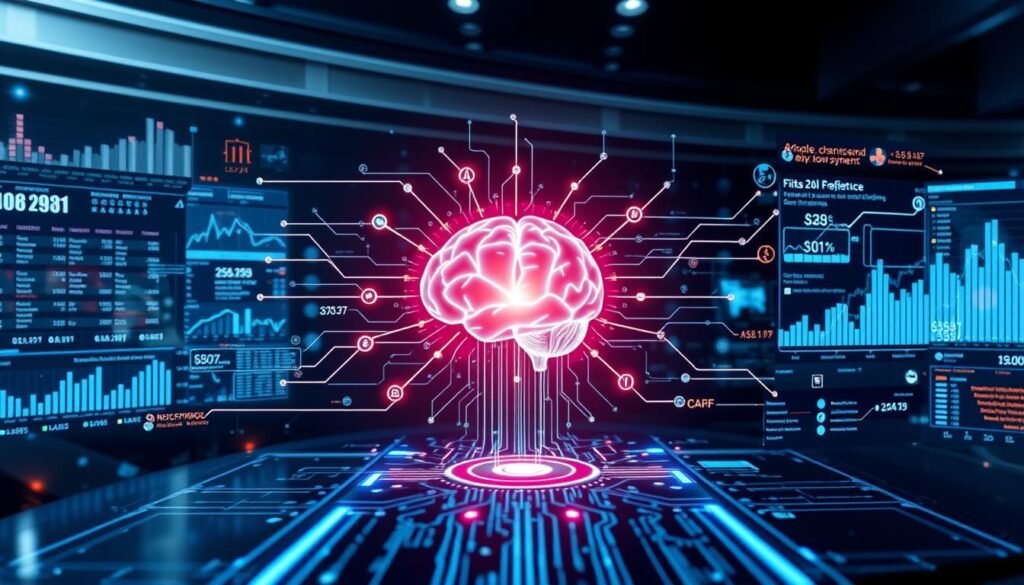As we look at financial transactions, a big question comes up: how can AI change how we fight financial crimes? With more complex fraud out there, AI’s role in stopping these crimes is key. We’re at a point where AI can make fraud detection better and help with following rules in banks and other financial places. By using AI, we can keep up with the fast pace of financial crimes. This ensures our ways to stop them stay as quick as the criminals are.
To see how AI is key in this fight, we can check out what experts say here.
Key Takeaways
- Artificial intelligence is increasingly vital in combatting financial crime.
- AI enhances fraud detection capabilities and compliance procedures.
- The evolving landscape of financial crime necessitates advanced technological solutions.
- AI can improve operational efficiencies within financial institutions.
- Implementing AI tools supports real-time adaptation to criminal behaviors.
The Rise of Financial Crimes in Today’s Economy
In recent years, financial crimes have grown more common and complex. Our global economy’s linkages make these crimes affect more than just banks. It’s vital to grasp their effects to protect ourselves.
The Impact of Financial Crimes on Global Economy
Financial crimes deeply affect our global economy. Fraud and money laundering cause trillions of dollars in losses each year. These crimes hurt banks and erode trust in markets, making things more expensive for everyone.
When fighting these crimes, economies lose resources meant for growth. Banks hit by fraud may see less investment, slowing down economic growth. This makes it harder for economies to recover.
Regulatory Responses to Financial Crime Threats
Regulators are boosting efforts to fight financial crimes. The SEC sees money laundering as a big risk for 2024, leading to stricter rules. Banks must follow these rules closely to avoid fines and stay safe.
With tougher rules, we need strong strategies for compliance and risk management. This helps us deal with the challenges of fighting financial crimes.
Understanding Artificial Intelligence and Machine Learning
In today’s fast-changing financial world, knowing about artificial intelligence and machine learning is key. These technologies are more than just buzzwords. They are crucial for better risk management and making financial operations more efficient. Let’s dive into what they mean and how they work together in finance.
Definitions and Differences: AI vs. ML
Artificial intelligence is a wide range of technologies that help machines think like humans. They can solve problems and make decisions on their own. Machine learning is a part of AI that lets systems learn from data and get better over time without needing to be told how.
How AI and ML Work in Financial Applications
In finance, AI and ML make managing risks and spotting fraud better. Banks and other financial firms use these tools to look through lots of data. This helps them find patterns or oddities that could mean fraud. Also, ML lets risk models change quickly, making financial predictions and checks more accurate.

| Feature | Artificial Intelligence | Machine Learning |
|---|---|---|
| Scope | Broader range of functions | Focused on data-driven learning |
| Learning | Mimics human intelligence | Improves through experience |
| Applications | Fraud detection, customer service | Risk modeling, predictive analytics |
| Data Dependency | Less dependent on data size | Requires large datasets for accuracy |
Using artificial intelligence and machine learning in finance makes things run smoother and keeps risks down. By getting to know these technologies, we can tackle financial crimes better.
How AI Can Assist in Fraud Detection
AI has changed how we fight financial fraud. It uses advanced technology to spot fraud quickly and effectively. This helps us stop fraud as it happens, keeping our money safe.
AI-Driven Fraud Detection Tools
AI tools use machine learning to look at transactions and find odd ones. This lets banks and other financial groups act fast on suspicious activities. Key features include:
- Real-time analytics: They check transactions right away to catch fraud instantly.
- Predictive models: AI uses past data to guess where fraud might happen next.
- Customizable parameters: Each company can set its own rules for spotting fraud.
Case Studies of Successful AI Implementations
Many companies have seen great results from using AI to fight fraud. Here are some examples:
| Company | Implementation | Results |
|---|---|---|
| JPMorgan Chase | AI to analyze client transactions for patterns | Reduced false positives by 50%, increasing operational efficiency |
| PayPal | Machine learning algorithms for user activity analysis | Enhanced user trust, leading to a 30% reduction in fraudulent transactions |
| Square | Real-time monitoring of transaction behaviors | Identified and prevented $1 million in fraud within the first quarter |
These stories show how AI helps us fight fraud better. By using AI, we can keep our money safer and protect our assets well.
AI Prevent Financial Crimes: A Review of Techniques
Exploring ways to fight financial crimes is key. Advanced technologies like predictive analytics and real-time monitoring are crucial. They help organizations use data wisely, making strong defenses against threats.
Predictive Analytics for Risk Management
Predictive analytics is vital in fighting AI prevent financial crimes. It looks at past data to spot signs of fraud. This way, we can predict risks better and make smarter choices.
Real-time Monitoring and Anomaly Detection
Real-time monitoring works with predictive analytics to give quick insights on transactions. It spots unusual transactions right away, helping us stop losses. This means our teams can act fast, preventing problems from getting worse.

Using predictive analytics and real-time monitoring makes our financial systems stronger. These methods reduce risks and make transactions safer. For more on advanced strategies, check out this resource. Staying updated with sites like AiNosu.com helps us understand the latest in AI solutions.
The Role of AI in Anti-Money Laundering Efforts
Today, fighting money laundering is a big challenge. AI helps us a lot in this fight. It makes our defenses stronger by improving how we watch transactions and know our customers.
Improving Transaction Monitoring Systems
AI changes how we watch transactions by making it faster and smarter. It spots suspicious activities right away. This means we can catch things we might have missed before.
Using AI for anti-money laundering can lead to:
- Increased accuracy in spotting fake transactions.
- Reduced false positives that can confuse teams.
- Faster response times to new threats.
Enhancing Know Your Customer (KYC) Processes
AI also helps with KYC processes. It makes checking identities and assessing risks faster and more accurate. This leads to better customer profiles and risk checks.
- Streamlined onboarding for new customers.
- Improved accuracy in customer profiles and risk checks.
- Continuous monitoring of how customers behave over time.
These changes make our anti-money laundering efforts stronger. By using smart transaction monitoring and detailed KYC processes, we can fight financial crime better.
Technologies Used in AI for Financial Crime Prevention
In today’s digital world, many new technologies are coming to fight fraud. Data analytics and machine learning algorithms are key in stopping financial crimes. They give real-time insights and help companies make smart choices.
Data Analytics and Financial Intelligence
Data analytics helps us spot unusual patterns and threats in finance. By using financial intelligence, companies can look through lots of data. This helps them see trends that might mean fraud. Advanced analytics are crucial for understanding risks and making better compliance strategies.
Machine Learning Algorithms for Pattern Recognition
Machine learning algorithms are vital for catching fraud today. They look at data to find oddities and forecast risks. As they learn more, they get better at spotting threats, making our defenses stronger. Using these advanced tools helps us stay ahead in managing financial risks.

| Technology Type | Function | Benefits |
|---|---|---|
| Data Analytics | Analyze large datasets for patterns | Improved risk assessment and compliance |
| Machine Learning Algorithms | Identify anomalies and predict risks | Enhanced accuracy and faster fraud detection |
| Financial Intelligence | Provide insights on potential threats | Informed decision-making and strategy refinement |
Challenges in Implementing AI Solutions
Adding AI to financial systems is tough. Old tech often makes it hard to integrate AI. It’s key to have data that works well with AI to make it useful.
Integrating AI into Existing Financial Systems
Adding AI needs a good plan. Banks must check if their tech can handle new tech. We should:
- Look at current systems to find problems.
- Upgrade tech to support AI.
- Make sure data is clean for AI to work right.
Planning ahead helps solve AI integration issues. Using modern data tools helps use AI better.
Overcoming Resistance to New Technologies
Many people are hesitant about new tech. Staff might worry about AI changes. To help them, we should:
- Train employees to understand AI better.
- Encourage a culture that values new ideas.
- Show how AI lowers risks in operations.
By tackling tech resistance, we make it easier to use AI. This leads to big improvements in finance.
For more tips on beating AI challenges, check out resources on overcoming AI barriers.
| Challenge | Solution |
|---|---|
| Legacy Technology | Upgrade systems to support AI functionalities |
| Data Compatibility | Ensure data integrity and quality |
| Employee Resistance | Provide training and promote a culture of innovation |
The Importance of Regulatory Compliance
Financial institutions must understand regulatory compliance to navigate the complex world of global rules. These rules help protect against financial crimes. They also show the need for strong systems to follow these rules.
Understanding Global Regulations on Financial Crimes
Global rules set strict policies to fight financial crimes. They cover anti-money laundering (AML) laws and know-your-customer (KYC) guidelines. These rules help make transactions transparent. By using advanced tools, institutions can meet these rules well.
Financial crime detection software is key in spotting suspicious activities. It helps follow international standards.
How AI Helps Meet Compliance Standards
AI tools are crucial for following rules. They keep up with changing rules automatically. This helps institutions stay on top of compliance issues.
AI can quickly and accurately look through lots of data. This makes KYC checks and fraud detection better.
Using AI also makes compliance easier and builds trust with regulators and clients. It automates routine tasks, letting compliance teams focus on important risk assessments. Adopting AI technology strengthens our commitment to strong compliance frameworks.

| Global Regulation | Primary Focus | AI Role |
|---|---|---|
| Anti-Money Laundering | Preventing illicit financial activities | Enhanced monitoring and reporting |
| Know Your Customer | Client identity verification | Automated checks and due diligence |
| Financial Action Task Force | Global standards for AML | Data analysis for adherence |
Understanding regulatory compliance and global rules helps us fight financial crime better. Using AI compliance solutions ensures we meet standards. It also helps in eradicating financial threats effectively.
For more on how AI is changing the regulatory landscape, this insightful resource offers valuable insights.
Cybersecurity and Financial Institutions
Cybersecurity is now key for financial institutions to protect data and stop financial crimes. As threats get more complex, it’s crucial to link cybersecurity with crime prevention. We need strong strategies to tackle the growing risks.
The Intersection of Cybersecurity and Financial Crime Prevention
Combining cybersecurity with crime prevention is essential. Financial institutions must tackle risks from data breaches to stop fraud. By improving our cybersecurity, we also fight financial crime better. This link between cybersecurity and AI is changing how we spot fraud in finance.
Technology lets us see threats better and respond faster. This helps us stay ahead of new threats.
AI’s Role in Strengthening Cybersecurity Measures
AI is key in boosting cybersecurity in finance. It uses advanced analytics to spot threats fast. This is vital in a world where threats change quickly.
By using AI, we can watch our systems closely and react fast to threats. This keeps our cybersecurity strong.
Keeping up with cybersecurity tech is important for finance. AI in our cybersecurity not only finds suspicious actions but also encourages us to always improve and adapt.
Cost Efficiency Through AI Solutions
Financial institutions face a complex market today. Using AI solutions is key. These technologies boost efficiency and cut costs. They help with many tasks, saving money and making better use of resources.
Reducing Operational Costs in Financial Institutions
AI helps streamline many financial tasks. For instance, it automates data processing and checks for compliance. This cuts down on time and labor costs.
Using AI tools, we find where costs can be cut and resources used better. Analyzing big data fast helps make quicker decisions and reduces the chance of mistakes.
The ROI of Investing in AI Technology
Investing in AI brings big returns. It boosts compliance and improves risk management. This helps financial institutions grow over time.
AI makes operations more efficient and improves customer experiences. This can lead to more revenue. With ongoing AI advancements, we’ll find more ways to grow and make more money.

Future Trends in AI and Financial Crime Prevention
The world of AI and fighting financial crimes is changing fast. New technologies are bringing big changes and new ways to tackle security issues. We need to look at what’s coming next to understand these changes better.
Emerging Technologies and Their Potential Impact
New tech is leading the way in fighting financial crimes. Tools like machine learning and advanced data analytics give us new insights. They help us spot suspicious activities and stop fraud more effectively.
- Machine Learning: Allows for the evolution of algorithms that learn from vast amounts of data, improving the ability to detect anomalies in real-time.
- Natural Language Processing: Facilitates the analysis of unstructured data, helping us uncover hidden risks by interpreting language used in communications and transactions.
- Robotic Process Automation: Streamlines repetitive tasks, freeing up valuable human resources for more complex investigations.
The Role of Blockchain in Financial Safety
Blockchain technology could greatly improve financial security. It offers a secure, transparent way to track transactions. This could make financial systems safer and less prone to fraud.
| Feature | Traditional Systems | Blockchain Systems |
|---|---|---|
| Centralization | Data controlled by a single entity, posing risks | Decentralized control, reducing single points of failure |
| Transparency | Limited visibility into transaction history | All transactions are visible to authorized participants |
| Fraud Prevention | Higher risk of data breaches and manipulation | Immutable records enhance security against fraud |

Combining blockchain with AI could change how we fight financial crimes. As we look to the future, it’s important to understand these trends. This will help us build strong financial systems that can handle new threats.
AI Adoption Roadblocks for Financial Institutions
Looking into the challenges of using AI in finance, we see both technical and financial hurdles. Big banks struggle with old systems, making it hard to add new tech. This can feel overwhelming.
Technical and Financial Barriers to Entry
AI tools face many technical challenges. Problems with old systems can slow down progress. The high costs for tech upgrades and staff training add to the hurdles.
Many worry about the high costs of adding AI. These costs include the tech itself, staff training, and changing how things work. Looking at financial barriers, we see a need for strong leadership to focus on long-term benefits.
Cultural Resistance within Organizations
Adding AI is often slowed by cultural resistance. Employees might be hesitant due to job security or doubts about new tech. Big banks have set ways of doing things, making change hard.
It’s key to overcome this resistance for AI to work well. Talking openly about AI’s benefits can ease fears and help understand how it supports employees. With the right approach, we can make a space that welcomes and sees the value in AI.

| Barrier Type | Description | Impact on Adoption |
|---|---|---|
| Technical Limitations | Integration issues with legacy systems | Delays in implementation |
| Financial Constraints | High upfront investment costs | Limited resources available for AI projects |
| Cultural Resistance | Employee reluctance to change | Slowed adoption and potential failures |
Collaborations Between Financial Institutions and Tech Companies
The financial industry is changing fast. It now needs partnerships between old banks and new tech companies. These partnerships help bring new ideas, make things more efficient, and fight fraud. We’ll look at how AI helps fight fraud in these partnerships.
The Rise of Fintech Partnerships
More and more, banks are working with tech companies. This helps them use the latest tech to keep things safe and run smoother. For example, Stripe and Square work with banks to make payments better and fight fraud.
Case Studies of Successful Collaborations
There are many examples of how these partnerships fight financial crime:
| Collaboration | Financial Institution | Technology Company | Focus Area | Outcome |
|---|---|---|---|---|
| HSBC & Zelle | HSBC | Zelle | Real-time payments | Enhanced transaction speed and security |
| Wells Fargo & Salesforce | Wells Fargo | Salesforce | Customer engagement analytics | Improved customer insights and fraud mitigation |
| BBVA & Stripe | BBVA | Stripe | Payment processing | Streamlined payment operations and reduced fraud risk |
These examples show how banks use tech companies’ ideas to get better at fighting fraud and keeping things safe.

Conclusion
In this article, we’ve looked at how AI helps prevent financial crimes. We’ve seen how advanced tech boosts fraud detection, makes compliance easier, and helps fight money laundering. With financial crimes getting more complex, AI is key in fighting back.
Looking ahead, financial institutions must keep up with new tech. We need to use AI to tackle current threats and prepare for new ones. By adding AI to our systems, we can make the financial world safer for everyone.
The path to a safer financial world needs commitment and teamwork. We call on all financial sector players to use AI to fight financial crimes. This way, we can manage risks better and rebuild trust in our financial systems.
FAQ
How can AI prevent financial crimes effectively?
What are the primary benefits of using machine learning for fraud detection?
What role does AI play in anti-money laundering efforts?
What challenges do financial institutions face in implementing AI solutions?
How does regulatory compliance influence AI adoption in financial institutions?
What is the significance of real-time monitoring in financial crime prevention?
Can AI contribute to cost efficiency within financial institutions?
How are fintech partnerships enhancing financial crime prevention?
Source Links
- https://www.forbes.com/councils/forbestechcouncil/2024/02/07/fighting-financial-crime-with-ai-is-not-a-trend-its-a-necessity/
- https://www.amlrightsource.com/news/impact-of-artificial-intelligence-on-financial-crime-what-is-possible/
- https://www.oliverwyman.com/our-expertise/insights/2018/dec/risk-journal-vol-8/rethinking-tactics/the-risks-and-benefits-of-using-ai-to-detect-crime.html





